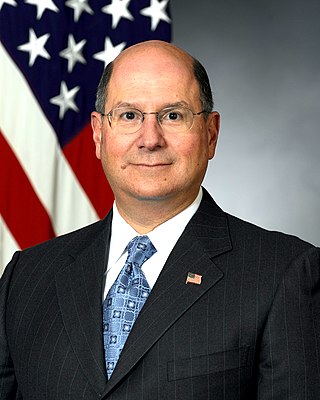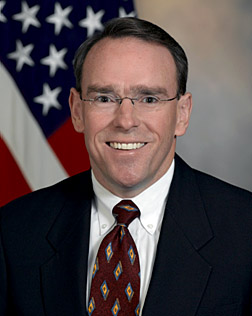Related Research Articles

The United States secretary of defense (SecDef) is the head of the United States Department of Defense, the executive department of the U.S. Armed Forces, and is a high ranking member of the federal cabinet. The secretary of defense's position of command and authority over the military is second only to that of the president of the United States, who is the commander-in-chief. This position corresponds to what is generally known as a defense minister in many other countries. The secretary of defense is appointed by the president with the advice and consent of the Senate, and is by custom a member of the Cabinet and by law a member of the National Security Council.

The Secretary of the Navy is a statutory officer and the head of the Department of the Navy, a military department within the United States Department of Defense.

The deputy secretary of defense is a statutory office and the second-highest-ranking official in the Department of Defense of the United States of America.

The vice chairman of the Joint Chiefs of Staff (VJCS) is, by U.S. law, the second highest-ranking military officer in the United States Armed Forces, ranking just below the chairman of the Joint Chiefs of Staff. The vice chairman outranks all respective heads of each service branch, with the exception of the chairman, but does not have operational command authority over their service branches. The vice chairman assists the chairman in exercising their duties. In the absence of the chairman, the vice chairman presides over the meetings of the Joint Chiefs of Staff and performs all other duties prescribed under 10 U.S.C. § 153 and may also perform other duties that the president, the chairman, or the secretary of defense prescribes.

Ashton Baldwin Carter was an American government official and academic who served as the 25th United States Secretary of Defense from February 2015 to January 2017. He later served as director of the Belfer Center for Science & International Affairs at Harvard Kennedy School.

The Defense Science Board (DSB) is a committee of civilian experts appointed to advise the U.S. Department of Defense on scientific and technical matters. It was established in 1956 on the recommendation of the second Hoover Commission.

The Air Staff is one of the Department of the Air Force's two statutorily designated headquarters staffs: the other staff is the Office of the Secretary of the Air Force, also known as the Secretariat. The Air Staff is headed by the Chief of Staff of the Air Force. The Air Staff is primarily composed of uniformed U.S. Air Force officials who assist the Chief of Staff in carrying out his dual-hatted role: as the principal military advisor to the Secretary of the Air Force, and as a member of the Joint Chiefs of Staff.
A United States defense standard, often called a military standard, "MIL-STD", "MIL-SPEC", or (informally) "MilSpecs", is used to help achieve standardization objectives by the U.S. Department of Defense.

Donald Charles Winter is an American politician and businessman who served as United States Secretary of the Navy. A former top executive of TRW, Aerospace & Defense, he was nominated in 2005 by President George W. Bush, confirmed by the United States Senate, and took the oath of office on January 3, 2006. In January 2009 Defense Secretary Robert Gates requested that Winter remain in office until President Obama picked his successor on March 13, 2009. He resigned on March 13.
The Joint Capabilities Integration and Development System (JCIDS) is the formal United States Department of Defense (DoD) process which defines acquisition requirements and evaluation criteria for future defense programs. JCIDS was created to replace the previous service-specific requirements generation system that allowed redundancies in capabilities and failed to meet the combined needs of all US military services. In order to correct these problems, JCIDS is intended to guide the development of requirements for future acquisition systems to reflect the needs of all four services by focusing the requirements generation process on needed capabilities as requested or defined by one of the US combatant commanders. In an ideal implementation of the JCIDS process, regional and functional combatant commanders give early and continuous feedback into the acquisition and sustainment processes to ensure their current and evolving requirements are known and met.

The under secretary of defense for intelligence and security or USD(I&S) is a high-ranking civilian position in the Office of the Secretary of Defense (OSD) within the U.S. Department of Defense (DoD) that acts as the principal civilian advisor and deputy to the secretary of defense (SecDef) and deputy secretary of defense (DepSecDef) on matters relating to military intelligence and security. The under secretary is appointed as a civilian by the president and confirmed by the Senate to serve at the pleasure of the president.

Joint Strike Fighter (JSF) is a development and acquisition program intended to replace a wide range of existing fighter, strike, and ground attack aircraft for the United States, the United Kingdom, Italy, Canada, Australia, the Netherlands, Denmark, Norway, and formerly Turkey. After a competition between the Boeing X-32 and the Lockheed Martin X-35, a final design was chosen based on the X-35. This is the F-35 Lightning II, which will replace various tactical aircraft, including the US F-16, A-10, F/A-18A-D, AV-8B, EA-6B and British Harrier GR7, GR9s and Tornado GR4. The projected average annual cost of this program is $12.5 billion with an estimated program life-cycle cost of $1.1 trillion.

The Defense Technical Information Center is the repository for research and engineering information for the United States Department of Defense (DoD). DTIC's services are available to DoD personnel, federal government personnel, federal contractors and selected academic institutions. The general public can access unclassified information through its public website.

John Jacob Young Jr. was United States Assistant Secretary of the Navy from 2001 to 2005 and Under Secretary of Defense for Acquisition, Technology and Logistics from 2007 to 2009. He is the founder and principal of JY Strategies, LLC.

The Under Secretary of Defense for Research and Engineering, abbreviated USD (R&E), is a senior official of the United States Department of Defense. The USD (R&E) is charged with the development and oversight of technology strategy for the DoD. The post has at various times had the titles Assistant Secretary of Defense for Research and Engineering, or Director of Defense Research and Engineering (DDR&E). The latter title has itself historically varied between the rank of under secretary and that of assistant secretary.
The Advanced Launch System (ALS) is a joint United States Air Force (USAF) and National Aeronautics and Space Administration (NASA) study which operated from 1987 to 1990. Its aim was to develop a flexible, modular, heavy-lift, high rate space launch vehicle that could deliver payloads to Earth orbit at a tenth the cost of existing boosters.
A United States data item description (DID) is a completed document defining the data deliverables required of a United States Department of Defense contractor. A DID specifically defines the data content, format, and intended use of the data with a primary objective of achieving standardization objectives by the U.S. Department of Defense. The content and format requirements for DIDs are defined within MIL-STD-963C, Data Item Descriptions (2014).

Patrick Michael Shanahan is a former United States federal government official who served as acting U.S. Secretary of Defense in 2019. President Donald Trump appointed Shanahan to the role after the resignation of Retired General James N. Mattis. Shanahan served as Deputy Secretary of Defense from 2017 to 2019. He previously spent 30 years at Boeing in a variety of roles.

The United States Army Acquisition Corps (AAC) is the officer / NCO corps of the United States Army Acquisition Workforce (AAW), a branch which includes civilians, officers, and NCOs. The Acquisition Corps is composed of army officers who serve in acquisition, a specialized form of product development, fielding, and support and Noncommissioned Officers who specialize in Contracting, Level I Program Management and Purchasing. These officers begin their careers in the other branches of the army for eight years, after which they may elect the Acquisition branch as their career as assistant program managers (APMs), program managers (PMs), and program executive officers (PEOs). The Noncommissioned Officers (NCOs) are reclassified in the Army Acquisition NCO Corps after serving 7-10 years in their respective enlisted career management fields, and serve primarily in the Army Acquisition Career Management Field - 51 and (MOS) 51C. 4% percentage of the Army Acquisition Officers serve among the 40,000 members of the army acquisition workforce, 6% in MOS 51C - Acquisition, Logistics and Technology Contracting Noncommissioned Officer, and the remainder 90% percentage consist largely of Department of the Army civilians.
References
- ↑ "Science Panel's SDI Criticism Omitted From Report". Washington Post. Retrieved 10 January 2023.
- ↑ Smith, R. Jeffrey. "SDI Plan Draws Military Critics". Washington Post. Retrieved 10 January 2023.
- ↑ "Defense Acquisition Board". Defense Acquisition University. Retrieved 9 January 2023.
- ↑ Sorenson, David S. (Dec 30, 2008). The Process and Politics of Defense Acquisition: A Reference Handbook: A Reference Handbook. ABC-CLIO. p. 30. ISBN 9780313348440 . Retrieved 10 January 2023.
- ↑ "Directive AD-A272 410" (PDF). DTIC. Department of Defense. Retrieved 9 January 2023.
- ↑ Cushman Jr., John H. (11 July 1987). "Production of Missile Approved". New York Times.
- ↑ McNicol, David L. (May 2013). "Evidence of the Effectiveness of the Defense Acquisition Board Process". DTIC. Institute for Defense Analyses. Retrieved 10 January 2023.